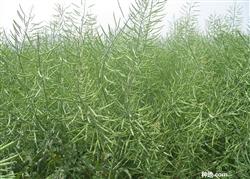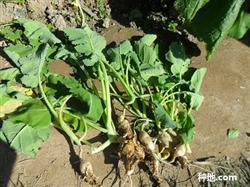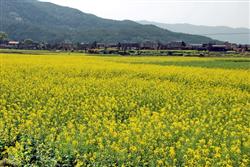How to plant rapeseed with high yield?

How to plant rapeseed with high yield? Please guide the cultivation of rapeseed to obtain high yield can refer to the following planting techniques: first, the variety selection adapts to the local cultivation of flower oil series or cloud oil series varieties. Second, after fine soil preparation and ploughing, rake fine mud blocks, the soil is loose and broken, and then open trenches to make boxes, with a width of about 2 meters, a width of 20 cm and a depth of 20 cm. Third, the sowing time, the sowing rate should be from mid-October to late October, 0.3-0.4 kg per mu. 4. Transplant at the right time, transplant in time when the age of reasonable close planting reaches 30-35 days, the row spacing is 1.2ft, the plant spacing is 0.6ft, and about 10000 plants are planted per mu. Seedlings should be checked and filled in time after seedling cultivation and transplanting. Scientific fertilization ① sufficient base fertilizer: 1000-2000 jin farm manure, 20 kg-25 kg phosphate fertilizer, 25 kg compound fertilizer or 10 kg urea per mu. ② early application of seedling fertilizer: direct seeding rape with 3 true leaves can be combined with inter-seedling to apply seedling fertilizer, urea 6 kg-8 kg per mu. For seedlings and transplanting, 8 kg-10 kg urea per mu was applied during the return to green period. ③ timely application of bolting fertilizer: rape bud bolting, urea per mu of about 10 kg, nitrogen, phosphorus and potassium compound fertilizer 6 kg-8 kg. ④ extra-root topdressing: 0.2% borax solution or potassium dihydrogen phosphate was sprayed on the leaves at the seedling stage and flowering and podding stage respectively to improve the seed setting rate. 6. the seedlings of direct seeding in the combination of intermediate ploughing and weeding are used for intermediate ploughing and weeding. For seedlings and transplanting, 20-30 days after transplanting, combined with fertilization to carry out intermediate ploughing and weeding. 7. Scientific drainage and irrigation: rape growth is afraid of both drought and waterlogging. In water management, drought can be irrigated and waterlogging can be drained, and border ditch and four-week ditch should be kept unobstructed so as to facilitate drainage and irrigation. Water demand is large during bolting and flowering period, so water supply should be ensured. Attention should be paid to prevent waterlogging in the field at seedling stage and flowering and podding stage. The main pests of rape are aphids, leafhoppers, Plutella xylostella and so on, which can be controlled by dichlorvos, dimethoate and pyrethroid pesticides. The main diseases are Sclerotinia sclerotiorum, downy mildew and so on, which can be controlled by topiramate, carbendazim, manganese zinc and other pesticides. 9. Timely harvest is about 30 days at the end of the full bloom of rape, about 2% of the pods are yellow, and most of the seeds in the pods can be harvested when they change from green to yellow or red. Click to get more rape planting techniques click to get more food crop planting techniques
- Prev

How to prevent and cure rape root swelling disease
How to prevent and cure rape root swelling disease? Please introduce that rape root swelling disease occurs in the root, the bacteria usually invade from the root hair or young root, and form a tumor on the main root or lateral root. It is commonly known as "brain shell disease". The initial surface is smooth and white, and then the color becomes brown, rough and cracked. It is easy to be infected by other germs and rot.
- Next

What should be paid attention to when planting rapeseed for high yield?
What should be paid attention to when planting rapeseed for high yield? Please introduce seed treatment: select disease-resistant varieties, sow seeds at the right time, and mix seeds with new high-fat membrane (which can be mixed with seed coating agent), which can ward off underground diseases and insects, isolate virus infection, do not affect germination and swelling function, and strengthen respiratory intensity. improve seed germination rate and seedling emergence rate. ...
Related
- The first cup of black tea in spring, the flavor and history of tea gardens in Kenya, Africa
- The computer can not only choose potatoes, but also grow tea rice. AI will grow winter oolong tea champion.
- It is not only the inflated tea bitten by insects, but also engraved with the four seasons tea in Beipu.
- The Oriental Beauty Tea Festival in Zhuxian County takes the stage at the weekend to experience the plus-size feast of oil tea.
- & quot; Oriental Beauty Tea & Exploration of Emei in Hsinchu, the hometown of quot;
- The new variety of strawberry "Tainong 1" dessert is the first choice with mellow aroma. Crimson gorgeous
- History of Tea in Taiwan: from Wild Inner Mountain to Export Tea Garden
- Two types of Taiwan Oriental Beauty Black Tea won the British three-Star Award for Childhood Tea Xiang Zhang Jiaqi changed from pilot to champion tea maker.
- Banana species and varieties: the planting history of Taiwan Xianren banana and dwarf banana is long, is banana disease resistant?
- Coffee planting Technology: Qianjie Coffee from Seedling to harvesting

